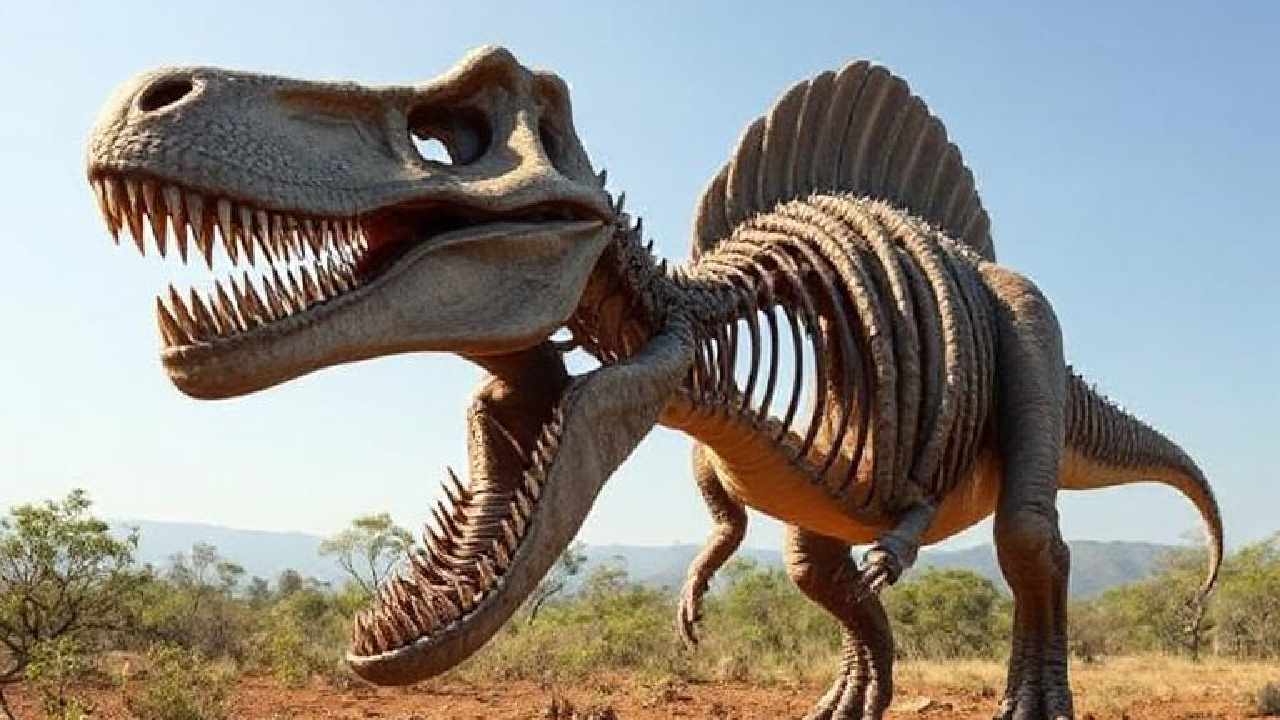Heard the strange internet question, “What dinosaur has 500 teeth?” You’re not alone. It’s one of the most Googled paleontology mysteries today.
The answer lies in the fascinating fossil record of a lesser-known herbivore — Nigersaurus taqueti. With a jaw that held hundreds of teeth at once, this dinosaur turned heads in more ways than one.
If you’re curious about how a dinosaur could function with 500 teeth, what it ate, and why its skull baffled scientists, you’re in for a treat.
Read on to uncover the anatomy, diet, and legacy of the dinosaur with 500 teeth — and understand why Nigersaurus deserves its moment in the spotlight.
What Dinosaur Has 500 Teeth?
So, what dinosaur has 500 teeth? The answer is Nigersaurus taqueti, a sauropod from the middle Cretaceous period. Unlike the massive, long-necked giants like Brachiosaurus, Nigersaurus stood out due to its unusually specialized mouth structure. Its jaw housed hundreds of small, column-like teeth arranged in tightly packed rows — giving it a lawnmower-like appearance.
Nigersaurus wasn’t just a gimmick in the fossil record. Its 500 teeth weren’t a fluke of nature but a highly evolved trait for efficient ground-level feeding. Scientists believe it replaced its teeth every 14 days, which makes it one of the fastest tooth-replacement cycles known in dinosaurs. This isn’t just about numbers; it’s about evolutionary innovation.
Understanding what dinosaur has 500 teeth leads to deeper questions about its lifestyle, ecology, and survival strategies in an ancient Sahara ecosystem.
Meet Nigersaurus: The 500 Tooth Dinosaur
Nigersaurus is more than just a viral internet meme. Named after the country of Niger where it was discovered, this dinosaur lived around 110 million years ago in what was once a lush, river-filled floodplain. Nigersaurus belonged to the Rebbachisauridae family, a lesser-known branch of sauropods.
It was relatively small — about 30 feet long — and weighed as much as a modern elephant. But its head and dental structure were what truly amazed paleontologists. Nigersaurus had a wide, straight-edged jaw unlike any other dinosaur of its kind. Its 500 teeth were arranged in batteries — rows designed for rapid replacement and constant feeding.
By studying Nigersaurus, scientists gained insight into how herbivorous dinosaurs diversified to occupy different niches. Its jaw structure was so strange that paleontologists initially thought it was distorted or incomplete — until more complete skulls confirmed its odd, efficient design.
The Dental Marvel: Anatomy & Function
What made the Nigersaurus teeth replacement system so revolutionary? For starters, it had more than 60 columns of teeth per jaw. Each column contained stacked replacement teeth, forming a conveyor belt-like system that ensured fresh teeth were always ready.
Nigersaurus teeth replacement occurred approximately every 14 to 30 days — one of the fastest dental cycles observed in vertebrates. The teeth themselves were small, spoon-shaped, and lightly built — perfect for cropping soft vegetation near the ground.
Unlike carnivorous dinosaurs with strong, tearing teeth, Nigersaurus’s teeth were delicate but efficient. They were used more like a rake than a chisel. This made sense considering its feeding habits and the type of environment it lived in.
This evolutionary marvel demonstrates that even gentle herbivores needed high-performance tools to survive. The 500-tooth setup was not excessive; it was essential.
Feeding Strategy & Diet
When it comes to Nigersaurus feeding habits, researchers believe it was a ground-level browser. Its snout was shaped to skim low vegetation — such as ferns, horsetails, and soft plants — rather than towering treetops.
The jaw opened wide and moved in a scissor-like motion, allowing it to clip vegetation with ease. Combined with the rapid tooth replacement system, this strategy allowed for almost continuous grazing. Nigersaurus was essentially the prehistoric equivalent of a lawn mower, clearing vast patches of undergrowth as it moved.
Its lightweight skull and wide jaws meant it could process food efficiently without needing to chew like modern herbivores. The dinosaur’s diet and feeding methods give us valuable insights into mid-Cretaceous ecosystems, especially in what’s now Northern Africa.
Skull Design & Adaptations
The skull of Nigersaurus was a biomechanical wonder. It was lightly built with thin bones and large openings to reduce weight. Despite its fragile look, the skull was strong enough to support constant feeding at ground level.
One striking adaptation was the position of its teeth — situated far to the front of its mouth, unlike most sauropods. This unusual configuration helped with quick vegetation cropping. The skull also featured expanded neural openings, hinting at advanced sensory capabilities that may have helped it detect food or predators.
These structural traits, while odd, were perfectly suited for its lifestyle — showing how evolution can tailor even the weirdest blueprints into successful survival strategies.
Paleontological Discovery & History
Nigersaurus was first discovered in the 1970s, but its significance wasn’t realized until the early 2000s. Paul Sereno, a renowned paleontologist from the University of Chicago, led a team that unearthed a nearly complete skull and skeleton in Niger.
The fossils were fragile and often shattered upon extraction, which delayed proper study for decades. But once reconstructed, the skull of Nigersaurus provided groundbreaking insights into sauropod diversity. It revealed just how specialized and regionally adapted some dinosaurs could be.
Today, Nigersaurus is featured in major exhibits and documentaries — not only for its odd appearance but for the way it reshaped our understanding of herbivorous dinosaurs in the mid-Cretaceous.
Comparisons & Records
In terms of comparisons, Nigersaurus is unlike any other known sauropod. Most herbivorous dinosaurs had robust skulls and fewer teeth. In contrast, Nigersaurus combined a lightweight skull with over 500 teeth — a rare evolutionary combo.
Even among its relatives like Diplodocus or Rebbachisaurus, Nigersaurus stands out for its unique dental structure. No other dinosaur matched its rapid tooth replacement speed and ground-level browsing adaptations.
While it might not win awards for size, Nigersaurus holds records for the most teeth and fastest dental turnover — making it a paleontological outlier in the best way possible.
Environment & Ecosystem Context
Nigersaurus lived in what’s now the Sahara Desert, but during the Cretaceous, this region was teeming with life. Floodplains, rivers, and dense vegetation created a lush environment — home to crocodilians, flying reptiles, and other dinosaurs.
The presence of Nigersaurus in this ecosystem reveals the complexity of food chains and habitat specialization. While predators like Suchomimus hunted fish, Nigersaurus kept its head down, quite literally, grazing away.
Its role in the ecosystem was crucial. By feeding on low-level plants, it helped shape the ground vegetation layer and supported ecological balance. This ground-level niche allowed other herbivores to thrive at different levels — from shrubs to treetops.
Cultural Impact & Media Presence
Nigersaurus has found an unlikely place in pop culture. The “dinosaur with 500 teeth” meme went viral, although often misused or misrepresented online. However, beyond the jokes, this attention reignited curiosity in paleontology.
Nigersaurus has appeared in documentaries like When Dinosaurs Roamed America and in museum exhibits around the world. Its skull structure, scanned using CT technology, became one of the first dinosaur skulls digitally reconstructed in full.
This dinosaur’s media presence has helped science communicators engage new audiences and debunk myths — proving that even viral curiosity can lead to genuine scientific interest.
Why It Matters: Scientific Significance?
Studying Nigersaurus isn’t just about counting teeth — it’s about understanding how evolution creates variety. Nigersaurus helps scientists grasp how sauropods diversified to fill ecological niches in different regions.
Its high tooth turnover rate, specialized feeding strategy, and skull design all contribute to our understanding of Cretaceous biodiversity. Moreover, it represents a successful survival strategy that defied typical dinosaur blueprints.
By studying creatures like Nigersaurus, researchers uncover how adaptability, not just strength or size, ensures survival. And that’s a lesson still relevant in biology and ecology today.
Conclusion
Nigersaurus may not be the biggest or most famous dinosaur, but its uniqueness has earned it a place in scientific history. With 500 teeth, a bizarre skull, and a specialized diet, it challenges everything we thought we knew about sauropods.
From its desert discovery to museum displays and viral fame, Nigersaurus has made a lasting impact. It reminds us that even the oddest creatures can reveal the most profound truths about life on Earth.
So next time someone asks “What dinosaur has 500 teeth?” — you’ll know there’s more to the answer than a meme. There’s a fascinating story, rooted in evolutionary brilliance.
Final Words
Nigersaurus offers a perfect case study of how form meets function in evolutionary biology. Its light frame, rapid dental renewal, and ground-feeding lifestyle all point to an animal finely tuned for its environment.
This dinosaur with 500 teeth isn’t just an answer to a viral question — it’s a gateway to understanding adaptation, specialization, and the rich ecological history of the mid-Cretaceous world.
Learning about Nigersaurus gives us a glimpse into the incredible variety that once roamed Earth, and the scientific value of even the strangest fossils.
Nigersaurus taqueti, a sauropod from the Cretaceous period, had over 500 replaceable teeth designed for ground-level grazing.
It was a herbivore. Its 500 teeth were designed to clip soft vegetation, not tear flesh.
Every 14–30 days, making it one of the fastest tooth-replacing dinosaurs ever found.
Roughly 30 feet long and weighed about 4 tons — similar to an elephant.
In the Republic of Niger, West Africa. Its first fossils were studied extensively in the early 2000s.










